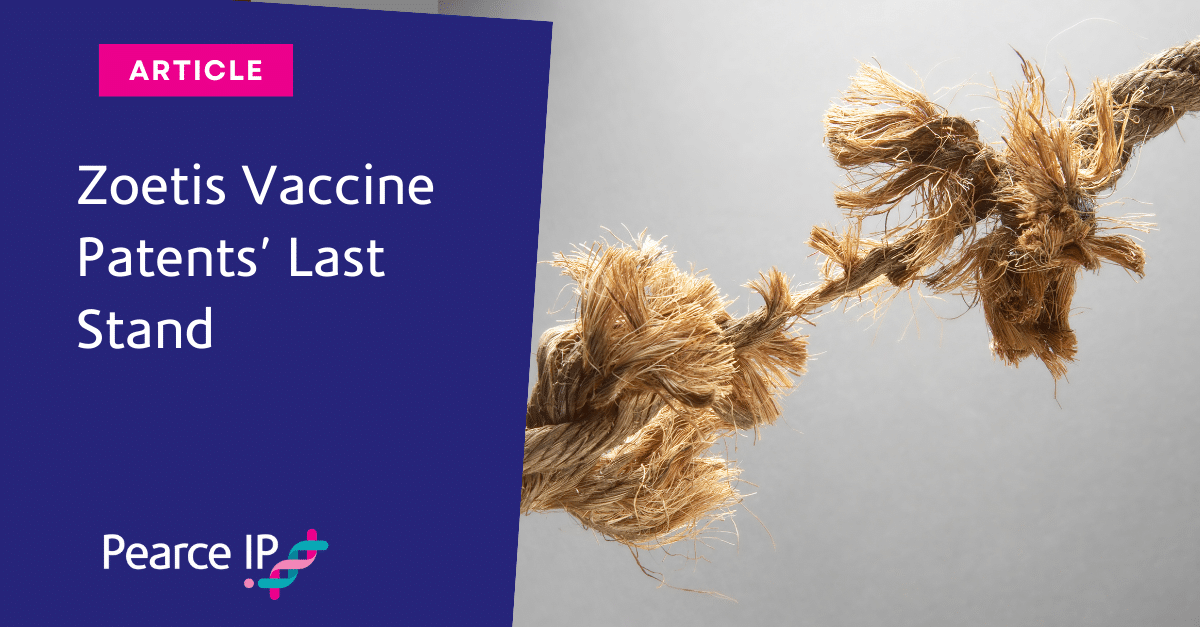Date:
Court:
Adjudicator:
26 March 2024
Federal Court Australia
Rofe J
Highlight
Justice Rofe has delivered a further supplementary decision in the dispute between Boehringer Ingelheim Animal Health USA Inc (Boehringer) and Zoetis Services LLC (Zoetis) in relation to three Zoetis vaccine patent applications. In an earlier decision, Justice Rofe had held that all claims (bar one) of the Zoetis patent applications were invalid and should not proceed to grant. Her Honour has now held the last remaining valid claim to be invalid for failure to disclose the best method of performing the claimed invention. So, all of Zoetis’ claims have now been held to be invalid and Boehringer’s opposition to the grant of the patent applications has been upheld in its entirety.
Background
Justice Rofe has delivered a further decision in the dispute between Boehringer and Zoetis in relation to three Zoetis patent applications (the 535, 537 and 540 Applications) directed to vaccines for treating enzootic pneumonia (also known as mycoplasmal pneumonia). Enzootic pneumonia is a chronic respiratory disease in pigs caused by a species of bacteria known as Mycoplasma hyopneumoniae (M. hyo). Justice Rofe’s decision supplements her Honour’s earlier decision in Boehringer Ingelheim Animal Health USA Inc v Zoetis Services LLC [2023] FCA 1119 (the First Decision).
By way of recap, the Zoetis patent applications are:
- The 535 Application for a “Mycoplasma hyopneumoniaevaccine”, a platform vaccine for protecting pigs against enzootic pneumonia;
- The 537 Application for a “PCV/Mycoplasma hyopneumoniaecombination vaccine” for protecting pigs against both enzootic pneumonia and Post-weaning Multisystemic Wasting Syndrome (PMWS) caused by porcine circovirus (PCV); and
- The 540 Application for a “PCV/Mycoplasma hyopneumoniae/PRRS combination vaccine” for protecting pigs against each of enzootic pneumonia, PCV and porcine reproductive and respiratory syndrome (PRRS) virus.
In the First Decision, Justice Rofe had held that, other than claim 2 of the 535 Application (which was directed to a culture supernatant purification step), all claims of the Zoetis patent applications were invalid and should not proceed to grant. Her Honour considered that the claims should not proceed to grant for one or more of the following reasons:
· the claim lacked an inventive step;
· the claim lacked support;
· the claim was not enabled, that is, the patent application did not disclose the invention in a manner which was clear enough and complete enough for the invention to be performed by a person skilled in the art;
· a failure to disclose the best method known to the applicant of performing the claimed invention; and/or
· the claim lacked a manner of manufacture.
With these patents hanging by a thread, the parties requested that her Honour provide supplementary reasons in relation to the validity of the dependent claims (already found to be invalid on the grounds above) on the other grounds of invalidity in issue in the case. Her Honour agreed to this request, leading to the supplementary decision on these additional invalidity grounds. Her Honour also addressed the issue of the costs of the proceedings in her supplementary decision.
Key Principle Applied by the Courts
Her Honour did not go into great detail on the key legal principles to be applied when considering the grounds of lack of inventive step, support, enablement and best method, given that her Honour had done so in the First Decision. However, as her Honour’s supplementary decision focussed on the validity of dependent claims, Justice Rofe emphasised that, when analysing the inventiveness of a dependent claim, it is not correct to:
- consider whether the particular integer added in the narrower, dependent claim adds anything inventive to the invention claimed in the broader, independent claim. The inventiveness of the entire combination must be assessed; or
- conclude that a dependent claim is necessarily obvious just because the broader claim on which it depends is obvious.
Issues
Inventiveness
Justice Rofe noted that each application proceeded in a “familiar fashion with a progressive narrowing of the invention claimed”. In each application:
- claim 1 broadly defined an immunogenic composition incorporating a hyo platform with additional antigens (in the case of the 537 and 540 Applications); and
- claim 2 introduced treating the soluble portion with Protein A or Protein G before being added to the immunogenic composition.
As already mentioned, only claim 2 of the 535 application had survived, as her Honour had held in the First Decision that the use of Protein A or Protein G in the reverse manner to treat a supernatant to remove antibodies and immunocomplexes, and thereby overcome the issue of both assay and immunological interference, was inventive.
The further dependent claims introduced additional integers such as further antigens, adjuvants and pharmaceutically acceptable carriers or related to kits, administration methods, dosage forms, and immunization methods. Justice Rofe considered all such claims to lack an inventive step. Her Honour did, however, consider claim 8 of the 537 Application to involve an inventive step. Claim 8 encompassed a composition of claims 1 to 7 further comprising at least one additional antigen from those listed including the 5 Pathogens but not PRRS. Her Honour found that:
- the process of developing a vaccine for a single virus in combination with the hyo platform, even when an antigen had been identified and developed, would involve a substantial research project with empirical work involving trial and error; and
- this would be even more so for a combination of the hyo platform, PCV-2 and one of the 5 Pathogens.
Best Method
Justice Rofe had not considered in the First Decision whether claim 2 of the 535 Application was invalid for failure to disclose the best method because Boehringer had not initially made a best method challenge to the invention claimed in claim 2. Boehringer ultimately, however, asserted lack of best method in its Second Further Amended Notice of Contention. The parties agreed that Justice Rofe’s findings in the First Decision regarding lack of best method applied to claim 2 of the 535 Application and therefore that the claim was invalid. Her Honour agreed with the parties’ position on this issue.
Support / Insufficient Disclosure – 535 and 537 Applications
Justice Rofe also found that the claims in the 535 and 537 Applications which claimed an immunogenic composition consisting of the spectrum from the one additional antigen to the M. hyo platform, plus all those antigens in the list, and all combinations thereof:
- lacked support because the breadth of such claims exceeded the technical contribution of the specification. These claims covered ways of achieving a result, being the spectrum of possible antigen combinations, which owed nothing to the disclosure of the specification; and
- were not enabled by the disclosure. Further, her Honour found that it was not plausible that the invention could be worked across the scope of the claims and that working the invention across the scope of the claims would require undue burden, requiring a significant research project.
Costs
As Boehringer had succeeded in invalidating all claims of the 535, 537, and 540 Applications, Boehringer submitted that costs should follow the event with Zoetis paying the costs of the proceedings on a party/party basis as well as its costs before the Commissioner of Patents. Zoetis, however, argued that each party should bear its own costs up to the date on which Boehringer was granted leave to amend its notice appeal and notice of contention to introduce the “lack of best method” ground, and that only after that date Zoetis should pay Boehringer’s costs on a party-party basis.
Justice Rofe ruled in favour of Boehringer, ordering Zoetis to pay Boehringer’s costs on a party-party basis for the proceedings, with a 10% discount for all costs incurred prior to the best method amendment on 19 August 2022 to account for the abandonment of several issues. Her Honour also directed Zoetis to pay Boehringer’s costs for the opposition proceedings before the Commissioner of Patents.
About Pearce IP
Pearce IP is a boutique firm offering intellectual property specialist lawyers, patent attorneys and trade mark attorneys to the life sciences industries (in particular, pharmaceutical, biopharmaceutical, biotech, ag-tech and food tech). Pearce IP is the 2021 ‘Intellectual Property Team of the Year’ (Lawyers Weekly Australian Law Awards) and was shortlisted for the same award in 2022. Pearce IP is ranked in IAM Patent 1000 and Managing IP (MIP) IP Stars, in Australasian Lawyer 5 Star Awards as a ‘5 Star’ firm, and the Legal 500 APAC Guide for Intellectual Property.
Our leaders have been recognised in virtually every notable IP listing for their legal, patent and trade mark excellence including: IAM Patent 1000, IAM Strategy 300, MIP IP Stars, Doyles Guide, WIPR Leaders, 5 Star IP Lawyers, Best Lawyers, and Australasian Lawyer 5 Star Awards, and have been honoured with many awards including Australian Law Awards – IP Partner of the Year, Women in Law Awards – Partner of the Year, Women in Business Law Awards – Patent Lawyer of the Year (Asia Pacific), Most Influential Lawyers (Changemaker), among other awards.

Naomi Pearce
CEO, Executive Lawyer (AU, NZ), Patent & Trade Mark Attorney (AU, NZ)
Naomi is the founder of Pearce IP, and is one of Australia’s leading IP practitioners. Naomi is a market leading, strategic, commercially astute, patent lawyer, patent attorney and trade mark attorney, with over 25 years’ experience, and a background in molecular biology/biochemistry. Ranked in virtually every notable legal directory, highly regarded by peers and clients, with a background in molecular biology, Naomi is renown for her successful and elegant IP/legal strategies.
Among other awards, Naomi is ranked in Chambers, IAM Patent 1000, IAM Strategy 300, is a MIP “Patent Star”, and is recognised as a WIPR Leader for patents and trade marks. Naomi is the 2023 Lawyers Weekly “IP Partner of the Year”, the 2022 Lexology client choice award recipient for Life Sciences, the 2022 Asia Pacific Women in Business Law “Patent Lawyer of the Year” and the 2021 Lawyers Weekly Women in Law SME “Partner of the Year”. Naomi is the founder of Pearce IP, which commenced in 2017 and won 2021 “IP Team of the Year” at the Australian Law Awards.

Helen Macpherson
Executive, Lawyer
Helen has over 25 years’ experience as an intellectual property specialist and is recognised as an industry leader. Helen advises on all forms of intellectual property including patents, plant breeder’s rights, trade marks, copyright and confidential information across a wide range of industries, including the pharmaceutical/biopharmaceutical, biotechnology, medical device, life sciences, agricultural, manufacturing and tech sectors.

Faran Shahzad
Foreign Qualified Lawyer (NZ)
Faran is a Foreign Qualified intellectual property lawyer (NZ) with a particular focus on patents and trade marks, managing contentious and non-contentious patent and trade mark matters, and assists with office actions.
With a background in physiology, Faran is passionate about life sciences industries. His focus is on patent and trade mark legal issues relevant to pharmaceuticals, biopharmaceuticals, biotechnology, food technology, and animal health.

